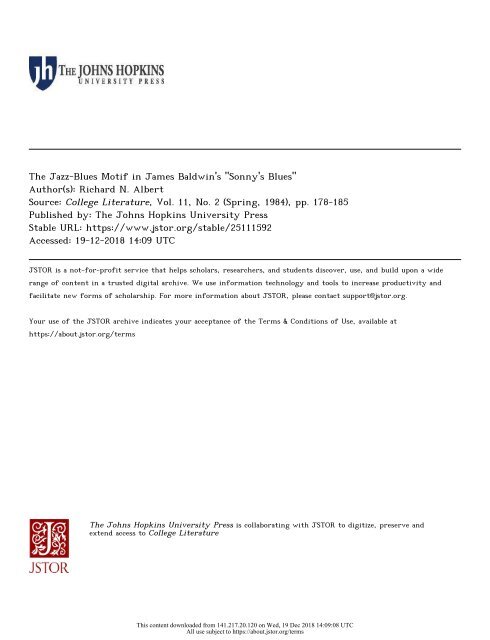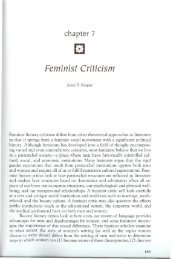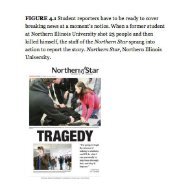The Jazz Blues Motif in James Baldwins Sonnys Blues
You also want an ePaper? Increase the reach of your titles
YUMPU automatically turns print PDFs into web optimized ePapers that Google loves.
<strong>The</strong> <strong>Jazz</strong>-<strong>Blues</strong> <strong>Motif</strong> <strong>in</strong> <strong>James</strong> Baldw<strong>in</strong>'s "Sonny's <strong>Blues</strong>"<br />
Author(s): Richard N. Albert<br />
Source: College Literature, Vol. 11, No. 2 (Spr<strong>in</strong>g, 1984), pp. 178-185<br />
Published by: <strong>The</strong> Johns Hopk<strong>in</strong>s University Press<br />
Stable URL: https://www.jstor.org/stable/25111592<br />
Accessed: 19-12-2018 14:09 UTC<br />
JSTOR is a not-for-profit service that helps scholars, researchers, and students discover, use, and build upon a wide<br />
range of content <strong>in</strong> a trusted digital archive. We use <strong>in</strong>formation technology and tools to <strong>in</strong>crease productivity and<br />
facilitate new forms of scholarship. For more <strong>in</strong>formation about JSTOR, please contact support@jstor.org.<br />
Your use of the JSTOR archive <strong>in</strong>dicates your acceptance of the Terms & Conditions of Use, available at<br />
https://about.jstor.org/terms<br />
<strong>The</strong> Johns Hopk<strong>in</strong>s University Press is collaborat<strong>in</strong>g with JSTOR to digitize, preserve and<br />
extend access to College Literature<br />
This content downloaded from 141.217.20.120 on Wed, 19 Dec 2018 14:09:08 UTC<br />
All use subject to https://about.jstor.org/terms
THE JAZZ-BLUES MOTIF<br />
IN JAMES BALDWIN'S<br />
"SONNY'S BLUES"<br />
by Richard N. Albert<br />
<strong>James</strong> Baldw<strong>in</strong>'s "Sonny's <strong>Blues</strong>," a popular selection among editors of<br />
anthologies used <strong>in</strong> <strong>in</strong>troductory college literature courses, is one of his<br />
most endur<strong>in</strong>g stories because it is less polemical than many of his later ef<br />
forts and because it offers several common literary themes: <strong>in</strong>dividualism,<br />
alienation, and "Am I my brother's keeper?" <strong>The</strong> story has also generated<br />
some perceptive critical views, some of which emphasize Baldw<strong>in</strong>'s meta<br />
phorical use of the blues.1 However, none of the criticism bothers to look<br />
more closely at the significance of the jazz and blues images and allusions <strong>in</strong><br />
relation to the commonly-agreed-upon basic themes of <strong>in</strong>dividualism and<br />
alienation.<br />
A closer exam<strong>in</strong>ation of Baldw<strong>in</strong>'s use of jazz and blues forms and of<br />
Louis Armstrong, Charlie Parker, the character Creole, and the song, "Am<br />
I Blue?" reveals some solid support for the basic themes, as well as some<br />
possible important thematic and structural flaws that might cause some<br />
readers to question whether Baldw<strong>in</strong> really understood the nature of the<br />
jazz/blues motif that he used. On the other hand, he may have <strong>in</strong>tentionally<br />
<strong>in</strong>jected "contraries" that imply an <strong>in</strong>terpretation which emphasizes a com<br />
<strong>in</strong>g together <strong>in</strong> harmony of all people?not just Sonny's brother and his<br />
people and culture.<br />
<strong>The</strong> blues, both as a state of be<strong>in</strong>g and as music, are basic to the structure<br />
of the story. Albert Murray says, "<strong>The</strong> blues as such are synonymous with<br />
low spirits,"2 and both the narrator and his brother Sonny have had their<br />
share. <strong>The</strong> narrator's major source of discontent has been his selfish desire<br />
to assimilate and lead a "respectable," safe life as a high-school algebra<br />
This content downloaded from 141.217.20.120 on Wed, 19 Dec 2018 14:09:08 UTC<br />
All use subject to https://about.jstor.org/terms
THE JAZZ-BLUES MOTIF 179<br />
teacher. When he learns of Sonny's troubles with drugs and the law, he feels<br />
threatened. Sonny, on the other hand, has a stormy relationship with his fa<br />
ther. He is unhappy <strong>in</strong> Harlem and hates school. He becomes alienated<br />
from his brother because of his jazz-oriented life style and his cont<strong>in</strong>ued<br />
attraction to Greenwich Village. F<strong>in</strong>ally, Sonny's us<strong>in</strong>g and sell<strong>in</strong>g hero<strong>in</strong><br />
leads to a jail sentence.<br />
<strong>The</strong> blues as music, as opposed to "the blues as such," take <strong>in</strong>to account<br />
both form and content. In this story, content (message) is all important. As<br />
music, the blues are considered by many blacks to be a reflection of and a<br />
release from the suffer<strong>in</strong>g they endured through and s<strong>in</strong>ce the days of slav<br />
ery. Joachim Berendt says, "Everyth<strong>in</strong>g of importance <strong>in</strong> the life of the<br />
blues s<strong>in</strong>ger is conta<strong>in</strong>ed <strong>in</strong> these [blues] lyrics: Love and racial discrim<strong>in</strong>a<br />
tion; prison and the law; floods and railroad tra<strong>in</strong>s and the fortune told by<br />
the gypsy; the even<strong>in</strong>g sun and the hospital . . . Life itself flows <strong>in</strong>to the lyr<br />
ics of the blues . . . ."3 When Sonny plays the blues at the end of the story,<br />
it is the black heritage reflected <strong>in</strong> the blues that impresses itself upon Son<br />
ny's brother and br<strong>in</strong>gs him back <strong>in</strong>to the community of his black brothers<br />
and sisters.<br />
Beyond this basic use of the blues motif as background for the unhappi<br />
ness of the narrator and Sonny and their resultant alienation from one an<br />
other, Baldw<strong>in</strong> uses the jazz motif to emphasize the theme of <strong>in</strong>dividualism.<br />
Sonny is clearly Thoreau's "different drummer." He is a piano player who<br />
plays jazz, a k<strong>in</strong>d of music noted for <strong>in</strong>dividuality because it depends on<br />
each musician's ability to improvise his or her own ideas while keep<strong>in</strong>g <strong>in</strong><br />
harmony with the progression of chords of some tune (often well-known).<br />
It has often been described as be<strong>in</strong>g able to take one's <strong>in</strong>strument, ma<strong>in</strong>ta<strong>in</strong><br />
an awareness of one's fellow players <strong>in</strong> the group, and <strong>in</strong> this context spon<br />
taneously "compose a new tune" with perhaps only a h<strong>in</strong>t of the orig<strong>in</strong>al re<br />
ma<strong>in</strong><strong>in</strong>g, except at the beg<strong>in</strong>n<strong>in</strong>g and end of the number. Ralph Ellison re<br />
fers to this as the jazz musician's "achiev<strong>in</strong>g that subtle identification be<br />
tween his <strong>in</strong>strument and his deepest drives which will allow him to express<br />
his own unique ideas and his own unique voice. He must achieve, <strong>in</strong> short,<br />
his self-determ<strong>in</strong>ed identity."4<br />
One of the greatest jazz improvisers of all time was Charlie Parker, Bald<br />
w<strong>in</strong>'s choice as the jazz musician that Sonny idolizes. No better choice could<br />
have been made. Parker was one of a group of young musicians <strong>in</strong> the late<br />
1940s and early 1950s who played what was called bebop, or bop. <strong>The</strong>y de<br />
veloped new and difficult forms?faster tempos, altered chords, and har<br />
monies that <strong>in</strong>volved greater ranges of notes which were frequently played<br />
This content downloaded from 141.217.20.120 on Wed, 19 Dec 2018 14:09:08 UTC<br />
All use subject to https://about.jstor.org/terms
180 COLLEGE LITERATURE<br />
at blister<strong>in</strong>g speeds. Parker was more <strong>in</strong>ventive and proficient than any of<br />
the others. His records are widely collected today, especially by young, as<br />
pir<strong>in</strong>g jazz musicians, and he rema<strong>in</strong>s an <strong>in</strong>spiration to many. An <strong>in</strong>divid<br />
ualist beyond compare not only <strong>in</strong> his music, but also <strong>in</strong> his life style, he<br />
died <strong>in</strong> 1955 at the age of 34, the victim of over-<strong>in</strong>dulgence <strong>in</strong> dr<strong>in</strong>k, drugs,<br />
and sex.<br />
That Sonny should have Parker, whose well-known nickname was<br />
"Bird," as an idol is important. Parker flew freely and soared to the heights<br />
<strong>in</strong> all aspects of his life. He was one of a k<strong>in</strong>d and he became a legend<br />
("Bird Lives" is a popular slogan <strong>in</strong> jazz circles even today). Sonny's life<br />
beg<strong>in</strong>s to parallel Parker's early. Joachim Berendt says of Parker: "He<br />
lived a dreary, joyless life and became acqua<strong>in</strong>ted with narcotics almost<br />
simultaneously with music. It is believed that Parker had become a victim of<br />
'the habit' by the time he was 15."5 So also, it seems, had Sonny. A further<br />
reference to Parker is made when the narrator th<strong>in</strong>ks of Sonny when he<br />
hears a group of boys outside his classroom w<strong>in</strong>dow: "One boy was whis<br />
tl<strong>in</strong>g a tune, at once very complicated and very simple, it seemed to be pour<br />
<strong>in</strong>g out of him as though he were a bird, and it sounded very cool and mov<br />
<strong>in</strong>g through all that harsh, bright air, only just hold<strong>in</strong>g its own through all<br />
those other sounds."6 <strong>The</strong> key words <strong>in</strong> this passage are "complicated,"<br />
"bird," and "hold<strong>in</strong>g its own through all those other sounds," all of which<br />
evoke the image of Bird Parker blow<strong>in</strong>g his cool and complicated im<br />
provisations over the accompaniment of the other members of a jazz com<br />
bo.<br />
When Sonny tells his brother that he is <strong>in</strong>terested <strong>in</strong> play<strong>in</strong>g jazz, the es<br />
sential difference of the two brothers becomes evident. Sonny expresses his<br />
admiration for Charlie Parker, whom the older brother had never heard of.<br />
For the narrator, jazz means Louis Armstrong. Armstrong certa<strong>in</strong>ly was a<br />
highly-regarded, popular jazz musician?probably the best known <strong>in</strong> the<br />
world, hav<strong>in</strong>g become known as Ambassador Satch because of his frequent<br />
trips abroad?but among bop musicians he represented the older, more<br />
traditional form of jazz.<br />
Baldw<strong>in</strong>'s equat<strong>in</strong>g Sonny with Parker and his brother with Armstrong is<br />
important because it emphasizes the difference between the two brothers<br />
with reference to both <strong>in</strong>dividualism and know<strong>in</strong>g oneself. Sonny refers to<br />
Armstrong as "old-time" and "down home" (p. 120). <strong>The</strong>re is a strong Un<br />
cle Tom implication <strong>in</strong> this and it is true that Armstrong was viewed this<br />
way by many of the young black musicians <strong>in</strong> the 1940s and 1950s. Had<br />
Armstrong become "the white man's nigger"? Had Sonny's brother? Prob<br />
This content downloaded from 141.217.20.120 on Wed, 19 Dec 2018 14:09:08 UTC<br />
All use subject to https://about.jstor.org/terms
THE JAZZ-BLUES MOTIF 181<br />
ably so. He had tried, as best he could, to reject his black self through be<br />
com<strong>in</strong>g a respectable math teacher and dissociat<strong>in</strong>g himself from black cul<br />
ture as much as possible. He was careful not to do those th<strong>in</strong>gs that he felt<br />
whites expected blacks to do. Baldw<strong>in</strong> understood this attitude, acknowl<br />
edg<strong>in</strong>g that only when he went to Europe could he feel comfortable listen<strong>in</strong>g<br />
to Bessie Smith, the well-known black blues s<strong>in</strong>ger of the 1920s and early<br />
1930s. However, <strong>in</strong> fairness to Sonny's brother, it must be noted that after<br />
World War II bop musicians and their music were the subject of consid<br />
erable controversy. Samuel Charters and Leonard Kunstadt observe: "<strong>The</strong><br />
pathetic attempts of Moslem identification, the open hostility, the use of<br />
narcotics?everyth<strong>in</strong>g was blamed on bop. It was the subject of vicious at<br />
tacks <strong>in</strong> the press, the worst s<strong>in</strong>ce the days of 'Unspeakable <strong>Jazz</strong> Must Go,'<br />
and the musicians were openly ridiculed."7 It is <strong>in</strong> this context that we must<br />
consider the narrator's concern about Sonny and the life style that he seems<br />
to be adopt<strong>in</strong>g.<br />
Up to the f<strong>in</strong>al section of the story, Baldw<strong>in</strong> uses jazz references well, but<br />
then some surpris<strong>in</strong>g "contraries" beg<strong>in</strong> to appear. As Sonny beg<strong>in</strong>s to play<br />
his blues <strong>in</strong> the last scene, he struggles with the music, which is <strong>in</strong>dicative of<br />
how he struggles with his life: "He and the piano stammered, started one<br />
way, got scared, stopped; started another way, panicked, marked time,<br />
started aga<strong>in</strong>; then seemed to have found a direction, panicked aga<strong>in</strong>, got<br />
stuck" (p. 138). As Sonny flounders about, Baldw<strong>in</strong> br<strong>in</strong>gs <strong>in</strong>to play two<br />
key references that lead and <strong>in</strong>spire Sonny to f<strong>in</strong>ally f<strong>in</strong>d himself through<br />
his music: <strong>The</strong> character of Creole and the play<strong>in</strong>g of the song "Am I<br />
Blue?" Baldw<strong>in</strong>'s use of these two elements is, to say the least, unusual.<br />
<strong>The</strong> use of Creole as the leader of the group Sonny plays with <strong>in</strong> this last<br />
and all-important section of the story is paradoxical. Baldw<strong>in</strong> seems to be<br />
emphasiz<strong>in</strong>g Sonny's br<strong>in</strong>g<strong>in</strong>g his brother back to a realization of the im<br />
portance of his roots as epitomized <strong>in</strong> Sonny's play<strong>in</strong>g of the blues. Why did<br />
Baldw<strong>in</strong> choose a leader who is not strictly representative of the black heri<br />
tage that can be traced back through the years of slavery to West Africa<br />
with its concomitant blues tradition that <strong>in</strong>cludes work songs, field hollers,<br />
and "African-<strong>in</strong>fluenced spirituals"?8 Creoles were generally regarded as<br />
descendants of French and Spanish settlers <strong>in</strong> Louisiana.9 Over the years,<br />
many Creole men took as mistresses light-sk<strong>in</strong>ned girls and produced that<br />
class referred to as black Creoles, many of whom passed for white and set<br />
themselves above the Negroes. From the early 1800s they were generally<br />
well-educated and cultured, some even hav<strong>in</strong>g gone to Europe to attend<br />
school. Music was also an important part of life among the Creoles. Ac<br />
This content downloaded from 141.217.20.120 on Wed, 19 Dec 2018 14:09:08 UTC<br />
All use subject to https://about.jstor.org/terms
182 COLLEGE LITERATURE<br />
cord<strong>in</strong>g to <strong>James</strong> Collier (and this is very important for the po<strong>in</strong>t I am mak<br />
<strong>in</strong>g),<br />
. . . <strong>The</strong> black Creole was what was called a "legitimate" musician. He could<br />
read music; he did not improvise; and he was familiar with the standard rep<br />
ertory of arias, popular songs, and marches that would have been conta<strong>in</strong>ed<br />
<strong>in</strong> any white musician's song bag. <strong>The</strong> po<strong>in</strong>t is important: <strong>The</strong> Creole musi<br />
cian was entirely European <strong>in</strong> tradition, generally scornful of the blacks from<br />
across the tracks who could not read music and who played those "low<br />
down" blues.10<br />
After the Civil War, the advent of Jim Crow laws deeply affected the stat<br />
us of black Creoles. In particular, the passage of Louisiana Legislative<br />
Code III was devastat<strong>in</strong>g <strong>in</strong> that it declared that any person "with any black<br />
ancestry, however remote, would be considered black."11 Many Creoles<br />
with musical tra<strong>in</strong><strong>in</strong>g were hard hit and sought work as musicians. <strong>The</strong> com<br />
petition with Negroes was keen and unpleasant, but eventually, Leroy Os<br />
transky notes, both groups "discovered each other's strengths and the re<br />
sult<strong>in</strong>g synthesis helped br<strong>in</strong>g about the first authentic jazz style, what came<br />
to be called the New Orleans style."12<br />
Though Creoles did contribute to the development of jazz as it is played<br />
<strong>in</strong> Baldw<strong>in</strong>'s story, it must be remembered that the story seems to emphasize<br />
the importance of the strictly black experience and tradition, which for<br />
most people means the heritage that <strong>in</strong>cludes not only post-Emancipation<br />
Jim Crow laws, but also the <strong>in</strong>dignities of slavery, the horrors of the mid<br />
dle-passage, and the cruelties of capture and separation from families <strong>in</strong><br />
West Africa. <strong>The</strong> black Creoles were not dist<strong>in</strong>ctly a part of that culture.<br />
<strong>The</strong> second confus<strong>in</strong>g element <strong>in</strong> the last section of the story is Baldw<strong>in</strong>'s<br />
use of the song "Am I Blue?" It is certa<strong>in</strong>ly not an example of the classic<br />
12-bar, 3-l<strong>in</strong>ed blues form.13 However, it might be po<strong>in</strong>ted out that <strong>in</strong> the<br />
context of this story it would not have to be, because Sonny is part of a jazz<br />
movement that is characterized by new ideas. Nevertheless, we must not<br />
forget the ma<strong>in</strong> thrust of the last scene: <strong>The</strong> narrator's rebirth and accept<br />
ance of his heritage. Certa<strong>in</strong>ly most musicologists would agree that blues<br />
music has a complexity that <strong>in</strong>cludes contributions from many sources, but<br />
the choice of song is questionable for other reasons.<br />
It would have seemed appropriate for Baldw<strong>in</strong> to have chosen some song<br />
that had been done by one of his favorite blues s<strong>in</strong>gers, Bessie Smith. In No<br />
body Knows My Name he says: "It was Bessie Smith, through her tone and<br />
her cadence, who helped me dig back to the way I myself must have spoken<br />
when I was a pickan<strong>in</strong>ny, and to remember the th<strong>in</strong>gs I had heard and seen<br />
and felt. I had buried them very deep."14 In relation to the idea of the nar<br />
This content downloaded from 141.217.20.120 on Wed, 19 Dec 2018 14:09:08 UTC<br />
All use subject to https://about.jstor.org/terms
THE JAZZ-BLUES MOTIF 183<br />
rator's rebirth through his experience of hear<strong>in</strong>g Sonny play the blues,<br />
choos<strong>in</strong>g a song made famous by Bessie Smith would have been fitt<strong>in</strong>g and<br />
would have reflected Baldw<strong>in</strong>'s personal experiences. But this is not the<br />
case.<br />
Why did Baldw<strong>in</strong> choose "Am I Blue?" a song far-removed fr<br />
black experience? It was written <strong>in</strong> 1929 by composer Harry Akst a<br />
cist Grant Clarke, who were both white, as far as I can determ<strong>in</strong>e. A<br />
born on New York's East Side, the son of a classical musician who<br />
viol<strong>in</strong> <strong>in</strong> various symphony orchestras and wished Harry to become<br />
cal pianist. However, Harry became a composer of popular music a<br />
tually worked with well-known show bus<strong>in</strong>ess personalities like Irv<br />
l<strong>in</strong> and Fred Astaire. One of his best-known songs is "Baby Face."<br />
Clarke was born <strong>in</strong> Akron, Ohio, and worked as an actor before go<br />
work for a music publisher. In 1912, his "Ragtime Cowboy Joe" be<br />
hit.<br />
Akst and Clarke wrote "Am I Blue?" specifically for Ethel Waters, an<br />
extremely popular black s<strong>in</strong>ger who had paid her dues and sung her share of<br />
the blues through the years, but who had by 1929 achieved fame on the<br />
stage and <strong>in</strong> films. <strong>The</strong> song was written for the film musical "On With the<br />
Show." Ethel Waters received a four-week guarantee <strong>in</strong> the mak<strong>in</strong>g of the<br />
film at $1,250 per week.15 Bessie Smith never achieved a comparable fame<br />
among general audiences. Ethel Waters seems to have been more <strong>in</strong> a class<br />
with Louis Armstrong <strong>in</strong> terms of general enterta<strong>in</strong>ment value and popular<br />
ity. <strong>The</strong> bop musician's po<strong>in</strong>t of view was antithetical to the Uncle Tom<br />
image they had of Armstrong. Ralph Ellison observes: "<strong>The</strong> thrust toward<br />
respectability exhibited by the Negro jazzmen of Parker's generation drew<br />
much of its immediate fire from their understandable rejection of the tradi<br />
tional enterta<strong>in</strong>er's role?a heritage from the m<strong>in</strong>strel tradition?exem<br />
plified by such an outstand<strong>in</strong>g creative musician as Louis Armstrong.16<br />
Why would Baldw<strong>in</strong> choose a song made popular by Ethel Waters, rather<br />
than one by his favorite, Bessie Smith?<br />
All of this is not to say that "Am I Blue?" is not <strong>in</strong> the blues tradition <strong>in</strong><br />
terms of message. <strong>The</strong> lyric expresses the sadness of a lonely woman whose<br />
man has left her, not unusual content for all forms of blues songs through<br />
the years. But it is what Paul Oliver refers to as one of those "synthetic<br />
'blue' compositions of the Broadway show and the commercial confections<br />
of 52nd Street that purport to be blues by the <strong>in</strong>clusion of the word <strong>in</strong> the ti<br />
tles."17 <strong>The</strong>refore, <strong>in</strong> view of the song's orig<strong>in</strong>, Baldw<strong>in</strong>'s fondness for Bes<br />
sie Smith, and the possible <strong>in</strong>tent of Sonny's play<strong>in</strong>g the blues to br<strong>in</strong>g the<br />
This content downloaded from 141.217.20.120 on Wed, 19 Dec 2018 14:09:08 UTC<br />
All use subject to https://about.jstor.org/terms
184 COLLEGE LITERATURE<br />
narrator back to an acknowledgment and affirmation of his roots, the<br />
choice of this particular song seems <strong>in</strong>appropriate.<br />
And yet Baldw<strong>in</strong> may have known what he was do<strong>in</strong>g. Is it possible that<br />
<strong>in</strong> "Sonny's <strong>Blues</strong>" he is <strong>in</strong>dicat<strong>in</strong>g that tradition is very important, but that<br />
change is also important (and probably <strong>in</strong>evitable) and that it builds on<br />
tradition, which is never fully erased but cont<strong>in</strong>ues to be an <strong>in</strong>tegral part of<br />
the whole? Ellison is aga<strong>in</strong> relevant here: "Perhaps <strong>in</strong> the swift change of<br />
American society <strong>in</strong> which the mean<strong>in</strong>g of one's orig<strong>in</strong>s are so quickly lost,<br />
one of the chief values of liv<strong>in</strong>g with music lies <strong>in</strong> its power to give us an ori<br />
entation <strong>in</strong> time. In do<strong>in</strong>g so, it gives significance to all those <strong>in</strong>def<strong>in</strong>able as<br />
pects of experience which nevertheless help to make us what we are."18<br />
Both Ellison and Baldw<strong>in</strong> seem to be say<strong>in</strong>g that we are an amalgam of<br />
many <strong>in</strong>gredients that have become fused over the centuries. We cannot sep<br />
arate ourselves, all people, from one another. Hav<strong>in</strong>g Sonny, <strong>in</strong>spired by<br />
Creole, play<strong>in</strong>g "Am I Blue?" for what we must assume is a racially mixed<br />
audience <strong>in</strong> a Greenwich Village club gives credence to these ideas and helps<br />
to expla<strong>in</strong> what might otherwise appear to be some <strong>in</strong>explicable <strong>in</strong>con<br />
gruities.<br />
NOTES<br />
1 For <strong>in</strong>stance, see John M. Reilly, " 'Sonny's <strong>Blues</strong>': <strong>James</strong> Baldw<strong>in</strong>'s Image of<br />
the Black Community," Negro American Literature Forum, 4 (July, 1970), 56<br />
60; Edward Lobb, "<strong>James</strong> Baldw<strong>in</strong>'s <strong>Blues</strong> and the Function of Art," <strong>The</strong> Inter<br />
national Fiction Review, 6, No. 2 (1979), 143-148; and Sigmund Ro, "<strong>The</strong> Black<br />
Musician as Literary Hero: Baldw<strong>in</strong>'s 'Sonny's <strong>Blues</strong>' and Kelley's 'Cry for<br />
Me,' " American Studies <strong>in</strong> Scand<strong>in</strong>avia, 7, No. 1 (1975), 17-48.<br />
2 Albert Murray, Stomp<strong>in</strong>g the <strong>Blues</strong> (New York: McGraw-Hill, 1976), p. 45.<br />
For an excellent technical explanation and def<strong>in</strong>ition of jazz, see Leonard<br />
Feather, '<strong>The</strong> Anatomy of <strong>Jazz</strong>," <strong>in</strong> his <strong>The</strong> New Edition of the Encyclopedia<br />
of <strong>Jazz</strong> (New York: Bonanza Books, 1955), pp. 60-78.<br />
3 Joachim Berendt, <strong>The</strong> <strong>Jazz</strong> Book, trans. Dan Morgenstern and Helmut and Bar<br />
bara Bredigkeit (New York: Laurence Hill & Company, 1975), pp. 139-140.<br />
4 Ralph Ellison, Shadow and Act (New York: Random House, 1964), p. 209.<br />
5 Berendt, p. 85.<br />
6 <strong>James</strong> Baldw<strong>in</strong>, "Sonny's <strong>Blues</strong>" <strong>in</strong> Go<strong>in</strong>g to Meet the Man (New York: <strong>The</strong><br />
Dial Press, 1965), p. 104. Further citations <strong>in</strong> the text will be from this edition.<br />
7 Samuel B. Charters and Leonard Kunstadt, <strong>Jazz</strong>: A History of the New York<br />
Scene (Garden City, New York: Doubleday & Company, Inc., 1962), p. 320.<br />
8 <strong>James</strong> Collier, <strong>The</strong> Mak<strong>in</strong>g of <strong>Jazz</strong>: A Comprehensive History (New<br />
York: Dell Publish<strong>in</strong>g Co., Inc., 1979), p. 61.<br />
This content downloaded from 141.217.20.120 on Wed, 19 Dec 2018 14:09:08 UTC<br />
All use subject to https://about.jstor.org/terms
THE JAZZ-BLUES MOTIF 185<br />
9 More detailed discussions of the Creoles can be found <strong>in</strong> Collier, pp. 59-62, and<br />
Berendt, pp. 135-147.<br />
10 Collier, p. 61.<br />
11 Leroy Ostransky, <strong>Jazz</strong> City: <strong>The</strong> Impact of Our Cities on the Development of<br />
<strong>Jazz</strong> (Englewood Cliffs, New Jersey: Prentice-Hall, Inc., 1978), p. 32.<br />
12 Ostransky, p. 32.<br />
13 See Ben Sidran, Black Talk (New York: Holt, R<strong>in</strong>ehart and W<strong>in</strong>ston, 1971), pp.<br />
34-37 and 84-87 for a good discussion of blues form. See also Albert Murray,<br />
Stomp<strong>in</strong>g the <strong>Blues</strong>, especially chapters 4-7.<br />
14 <strong>James</strong> Baldw<strong>in</strong>, Nobody Knows My Name (New York: <strong>The</strong> Dial Press, 1961),<br />
p. 5.<br />
15 Ethel Waters with Charles Samuels, His Eye Is On the Sparrow (Garden City,<br />
New York: Doubleday& Company, Inc., 1951), p. 198.<br />
16 Ellison, p. 225.<br />
17 Paul Oliver, <strong>The</strong> Mean<strong>in</strong>g of the <strong>Blues</strong> (New York: Collier Books, 1963), p. 23.<br />
18 Ellison, p. 198.<br />
This content downloaded from 141.217.20.120 on Wed, 19 Dec 2018 14:09:08 UTC<br />
All use subject to https://about.jstor.org/terms







